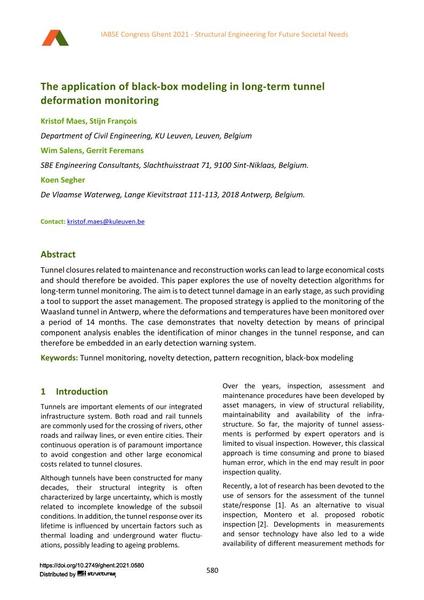The application of black-box modeling in long-term tunnel deformation monitoring

|
|
|||||||||||
Bibliografische Angaben
| Autor(en): |
Kristof Maes
(Department of Civil Engineering, KU Leuven, Leuven, Belgium)
Stijn François (Department of Civil Engineering, KU Leuven, Leuven, Belgium) Wim Salens (SBE Engineering Consultants, Slachthuisstraat 71, 9100 Sint-Niklaas, Belgium.) Gerrit Feremans (SBE Engineering Consultants, Slachthuisstraat 71, 9100 Sint-Niklaas, Belgium.) Koen Segher (De Vlaamse Waterweg, Lange Kievitstraat 111-113, 2018 Antwerp, Belgium.) |
||||
|---|---|---|---|---|---|
| Medium: | Tagungsbeitrag | ||||
| Sprache(n): | Englisch | ||||
| Tagung: | IABSE Congress: Structural Engineering for Future Societal Needs, Ghent, Belgium, 22-24 September 2021 | ||||
| Veröffentlicht in: | IABSE Congress Ghent 2021 | ||||
|
|||||
| Seite(n): | 580-587 | ||||
| Anzahl der Seiten (im PDF): | 8 | ||||
| DOI: | 10.2749/ghent.2021.0580 | ||||
| Abstrakt: |
Tunnel closures related to maintenance and reconstruction works can lead to large economical costs and should therefore be avoided. This paper explores the use of novelty detection algorithms for long-term tunnel monitoring. The aim is to detect tunnel damage in an early stage, as such providing a tool to support the asset management. The proposed strategy is applied to the monitoring of the Waasland tunnel in Antwerp, where the deformations and temperatures have been monitored over a period of 14 months. The case demonstrates that novelty detection by means of principal component analysis enables the identification of minor changes in the tunnel response, and can therefore be embedded in an early detection warning system. |
||||
| Copyright: | © 2021 International Association for Bridge and Structural Engineering (IABSE) | ||||
| Lizenz: | Die Urheberrechte (Copyright) für dieses Werk sind rechtlich geschützt. Es darf nicht ohne die Zustimmung des Autors/der Autorin oder Rechteinhabers/-in weiter benutzt werden. |
||||
